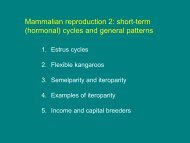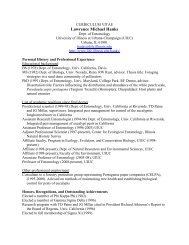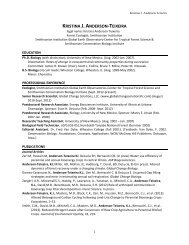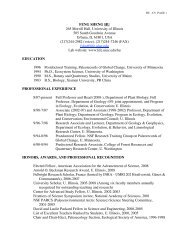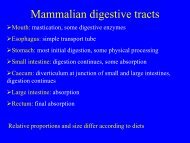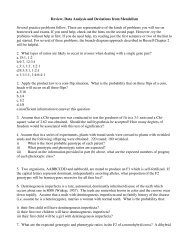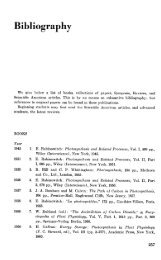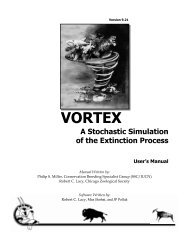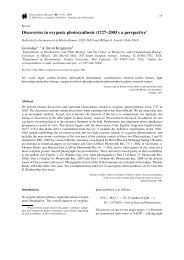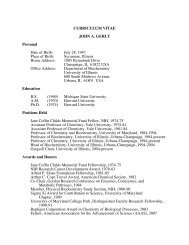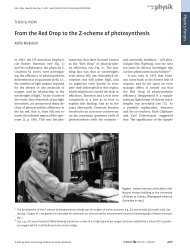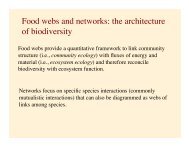You also want an ePaper? Increase the reach of your titles
YUMPU automatically turns print PDFs into web optimized ePapers that Google loves.
IB 201 <strong>Practice</strong> <strong>Midterm</strong><br />
Part 1. Matching. In the following numbered questions (on the left), chose from the possible answers<br />
given by the letters (on the right). Not all answers are used, and some answers might be used more than<br />
once. 3 points each. Total 30 points.<br />
1. When the expression of one gene pair masks or<br />
modifies the expression of another, the genes<br />
are said to exhibit _____c__ .<br />
2. Male pattern baldness is thought to be a<br />
_____n______ trait.<br />
3. Hairy ears in humans is a _____s_______ trait.<br />
4. Chromosomes that are not sex chromosomes are<br />
______a________.<br />
5. Expansion of a ____p_____ into the “full<br />
mutation” range is the cause of the most<br />
common type of inhertited mental retardation.<br />
6. The most common type of inherited mental<br />
retardation is __________e____________.<br />
7. Male mammals are the ______f________ sex.<br />
8. An XXY fruit fly with a normal set of<br />
autosomes is what gender? ___d____.<br />
9. An XO human suffers from what condition?<br />
___q____<br />
10. An ZW chicken is what gender? ___d____<br />
1<br />
a) autosomes<br />
b) dominance<br />
c) epistasis<br />
d) female<br />
e) Fragile-X syndrome<br />
f) heterogametic<br />
g) homogametic<br />
h) Huntington disease<br />
i) intersex<br />
j) Klinefelter Syndrome<br />
k) male<br />
l) recessive mutation<br />
m) recessiveness<br />
n) sex limited<br />
o) sex-linked<br />
p) 3-base (triplet) repeat<br />
q) Turner Syndrome<br />
r) X-linked<br />
s) Y-linked<br />
Part 2. Multiple Choice Questions. Pick the best answer among the choices given.<br />
1. A cross is made between two individuals of genotypes Aa bb Cc Dd Ee Ff and aa BB cc Dd ee ff.<br />
What is the probability of producing the genotype aa bb cc dd ee ff?<br />
a) 0<br />
b) 1/32<br />
c) 1/64<br />
d) 1/128<br />
e) 1/256<br />
f) none of the above
2. You find phenotypic variation in body color in a species of earthworm. You cross a pure-breeding red worm<br />
with a pure-breeding yellow worm. The F1 offspring from this cross are all red. You self-fertilize one of these<br />
F1 offspring, and you see the following phenotypic ratios in the offspring: 207 red: 68 brown: 93 yellow. Which<br />
of the following mechanisms do you think controls skin color in this species?<br />
a) two genes, complete dominance<br />
b) one gene, normal dominance<br />
c) one gene, epistasis<br />
d) two genes, incomplete dominance<br />
e) two genes, epistasis<br />
3. In humans, there is a dominant allele that causes vitiligo, where small-unpigmented spots appear on the body.<br />
Also, there is a recessive allele for another gene that causes albinism, which causes the entire body to be<br />
unpigmented. Vitiligo cannot be seen in albinos. A man with vitiligo had an albino mother and normal father. If the<br />
man has a child by a phenotypically normal skinned woman who had an albino father, what is the probability of<br />
having a phenotypically normal child?<br />
a) 0<br />
b) 1/8<br />
c) 1/4<br />
d) 3/8<br />
e) 1/2<br />
f) 5/8<br />
g) None above are correct.<br />
4. In some plants, a red pigment (cyanidine) is synthesized from a colorless precursor. The addition of a<br />
hydroxyl group to the cyanidine molecule causes it to become purple. In a cross between two purple plants, the<br />
following results are obtained: 94 purple; 31 red; 43 colorless. Of the following list, what were the most likely<br />
genotypes of the parental purple plants?<br />
a) Aa and Aa<br />
b) AA and aa<br />
c) Aa and aa<br />
d) AABB and aabb<br />
e) AAbb and aaBB<br />
f) AaBb and AaBb<br />
5. Two Manx cats are mated. In a large litter, two-thirds of the kittens are Manx and one-third have normal<br />
tails. Which symbols below most accurately describe the genotypes of the parental cats?<br />
a) M/+ and +/+<br />
b) M/M and +/+<br />
c) M/+ and M/+<br />
d) M/- and +/+<br />
e) M/M and M/+<br />
2
6. Male and female yellow mice are crossed. Over several litters, a 2:1 ratio of yellow to wild-type (agouti)<br />
pups were produced. If the symbol “Y” represents the allele associated with yellow body color, which symbols<br />
below most accurately describe the genotypes of the offspring?<br />
a) Yy and yy<br />
b) YY and yy<br />
c) Yy and Yy<br />
d) YY and Yy<br />
e) yy and yy<br />
f) None of the above<br />
7. The fourth (ring) finger of humans may be longer or shorter than the second (index) finger. The<br />
short index finger is produced by an autosomal allele that is dominant in men and recessive in<br />
women. What kinds of children and in what proportions would the following marriage be likely to<br />
produce: heterozygous long-fingered woman x homozygous short-fingered man. Give sex and<br />
finger length of children.<br />
a) All long-fingered girls; all long-fingered boys<br />
b) all short-fingered girls; all short-fingered boys<br />
c) All long-fingered girls; ½ long-fingered and ½ short fingered boys<br />
d) ½ long-fingered and ½ short-fingered girls; ½ long-fingered and ½ short fingered boys<br />
e) ½ long-fingered and ½ short-fingered girls; all long-fingered boys<br />
f) none of the above<br />
8. Black and orange pigments in the coats of cats are determined by an X-linked pair of alleles, c b (black) and<br />
c o (orange). Females are either black (c b c b ), orange (c o c o ) or tortoiseshell with patches of black and patches<br />
of orange (c b c o ). Males are either black (c b Y) or orange (c o Y). What genotypes and phenotypes would be<br />
expected among the offspring of a cross between a black female and an orange male?<br />
a) all orange males; all black females<br />
b) all black males; all orange females<br />
c) all orange males; all tortoiseshell females<br />
d) all black males; all tortoiseshell females<br />
e) all tortoiseshell males; all black females<br />
f) none of the above<br />
9. The barred pigmentation pattern of the Barred Plymouth Rock breed of chickens consists of white<br />
wing bars on black feathers. This pattern is determined by a dominant Z-linked gene (B). The<br />
recessive allele of this gene (b) produces a nonbarred (plain) wing coloration. What phenotypic ratio is expected<br />
among the progeny of a cross between a barred female and a nonbarred male? (Include sex and phenotype<br />
information.)<br />
a) barred females and barred males<br />
b) barred females and non-barred males<br />
c) non-barred females and non-barred males<br />
d) non-barred females and barred males<br />
e) none of the above<br />
3
10. Fragile X syndrome is caused by expansion of the number of CGG repeats in a region immediately adjacent<br />
to the FMR-1 gene. Expansion occurs from the normal range (~6 to ~50 repeats) to the permutation range (~55<br />
to ~230 repeats) to the full mutation range (>230 repeats). Expansion to the full mutation tends to occur in the<br />
offspring of individuals with permutations, but not in the offspring of individuals within the normal range. This<br />
condition is an example of a kind of inheritance called:<br />
a) incomplete penetrance<br />
b) genotype-environment interaction<br />
c) genetic anticipation<br />
d) recessive X-linked inheritance<br />
e) dominant X-linked inheritance<br />
χ 2 Test:<br />
Formulae, etc.<br />
! 2 (O-E)<br />
= " E<br />
2<br />
χ 2 Table<br />
Probabilities<br />
df 0.90 0.50 0.20 0.05 0.01 0.001<br />
1 0.02 0.46 1.64 3.84 6.64 10.83<br />
2 0.21 1.39 3.22 5.99 9.21 13.82<br />
3 0.58 2.37 4.64 7.82 11.35 16.27<br />
4 1.06 3.36 5.99 9.49 13.28 18.47<br />
4



